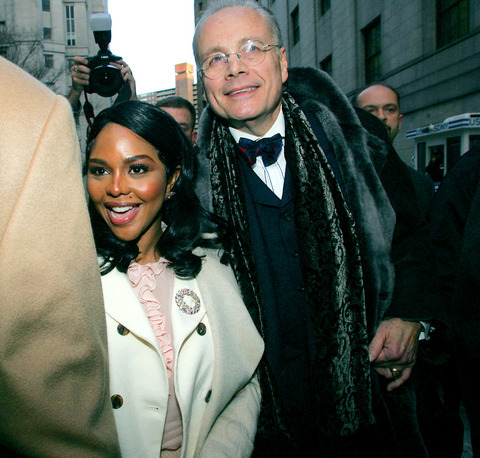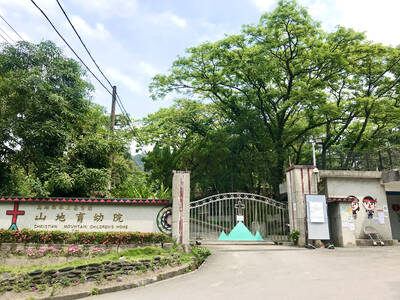The rapper Lil' Kim took a legal gamble on Thursday by testifying in her own defense in New York in her federal perjury trial, saying that "I did the best I could" before a grand jury in 2003 but that she had felt intimidated by a prosecutor.
The rap star, whose real name is Kimberly Jones, surprised prosecutors by taking the stand at midmorning, testifying for three and a half hours. Speaking about her grand jury appearance, she said she had not wanted to identify a friend because she was not certain he was the man in a photograph she was shown.
But in the afternoon prosecutor Cathy Seibel tore into the credibility of many of Jones' statements.

PHOTO:NY TIMES
Jones, 30, is accused in US District Court in Manhattan of lying to the grand jury and obstructing justice because of the account she gave of a shootout on Feb 25, 2001, in front of the Hot 97 radio station in Manhattan.
Jones said she did not see Damion Butler, a rap producer known as D-Roc, who was then her manager, at the radio station that day. She also said she did not know the person in the photograph, Suif Jackson, a road manager who Jones acknowledged Thursday had been her friend since both were teenagers.
Jones clung tenaciously to her version that the photograph did not look like Jackson. "It could be Gutta," she testified, using Jackson's rap name, "but I didn't want to make a positive identity. I just wasn't sure."
She said that the prosecutor who questioned her, Daniel Gitner, an assistant US attorney, never asked her directly if she knew Jackson. She was just as insistent that she did not recall seeing Butler anywhere during her visit to Hot 97 that Sunday afternoon as she was making an hour-long appearance as a guest disc jockey.
She said she was thrown off by Gitner's questions. "I was a victim there, I was almost shot," Jones said. "I couldn't believe I was being badgered."
Under questioning by Mel Sachs, her lead defense lawyer, Jones described a series of increasingly angry tiffs she had with Butler and Jackson, seeking to debunk the prosecutors' theory that she had lied to protect them.
She said she had fought with Butler about a scuffle that erupted among her crew while she was making a music video in June 2001 with the singer Phil Collins. She accused Butler of stealing two watches and a ring from her, including a Rolex she valued at US$60,000. The valuables were worth a total of US$110,000, she said.
"I'm so happy I'm away from them," she said of her former friends. "They did me so wrong."
Butler and Jackson pleaded guilty to federal weapons charges from the shootout, in which one person was injured.
Jones projected a strikingly different image from her dirty-talking, scantily clad rap persona. She appeared in a white suit jacket with an apricot blouse and a prim ruffle down the front. Jones sought to distance herself from Lil' Kim.
"I'm really nothing like my music, a lot of people say," she said.
Seibel opened her cross-examination by forcing Jones to recognize herself in a video shot by a security camera that showed Jones standing inches away from Butler on the street near Hot 97, even as he pulled a handgun and started firing.
Under the prosecutor's questions, Jones claimed she did not remember going to a prison to recover money from Butler, who was carrying US$10,000 in cash when he was arrested on a marijuana charge. Jones also tried to deny that she had written rhymes attacking a rival rapper named Foxy Brown, whose real name is Inga Marchand, even though one song named Marchand's group by name. "It's just entertainment," Jones said.
Toward the end, Seibel appeared to overplay her hand at times. The prosecutor pressed Jones at length about small details in her grand jury testimony, causing exasperation in the gallery, which was packed with her relatives and supporters.

May 18 to May 24 Pastor Yang Hsu’s (楊煦) congregation was shocked upon seeing the land he chose to build his orphanage. It was surrounded by mountains on three sides, and the only way to access it was to cross a river by foot. The soil was poor due to runoff, and large rocks strewn across the plot prevented much from growing. In addition, there was no running water or electricity. But it was all Yang could afford. He and his Indigenous Atayal wife Lin Feng-ying (林鳳英) had already been caring for 24 orphans in their home, and they were in

President William Lai (賴清德) yesterday delivered an address marking the first anniversary of his presidency. In the speech, Lai affirmed Taiwan’s global role in technology, trade and security. He announced economic and national security initiatives, and emphasized democratic values and cross-party cooperation. The following is the full text of his speech: Yesterday, outside of Beida Elementary School in New Taipei City’s Sanxia District (三峽), there was a major traffic accident that, sadly, claimed several lives and resulted in multiple injuries. The Executive Yuan immediately formed a task force, and last night I personally visited the victims in hospital. Central government agencies and the

Australia’s ABC last week published a piece on the recall campaign. The article emphasized the divisions in Taiwanese society and blamed the recall for worsening them. It quotes a supporter of the Taiwan People’s Party (TPP) as saying “I’m 43 years old, born and raised here, and I’ve never seen the country this divided in my entire life.” Apparently, as an adult, she slept through the post-election violence in 2000 and 2004 by the Chinese Nationalist Party (KMT), the veiled coup threats by the military when Chen Shui-bian (陳水扁) became president, the 2006 Red Shirt protests against him ginned up by

As with most of northern Thailand’s Chinese Nationalist Party (KMT) settlements, the village of Arunothai was only given a Thai name once the Thai government began in the 1970s to assert control over the border region and initiate a decades-long process of political integration. The village’s original name, bestowed by its Yunnanese founders when they first settled the valley in the late 1960s, was a Chinese name, Dagudi (大谷地), which literally translates as “a place for threshing rice.” At that time, these village founders did not know how permanent their settlement would be. Most of Arunothai’s first generation were soldiers